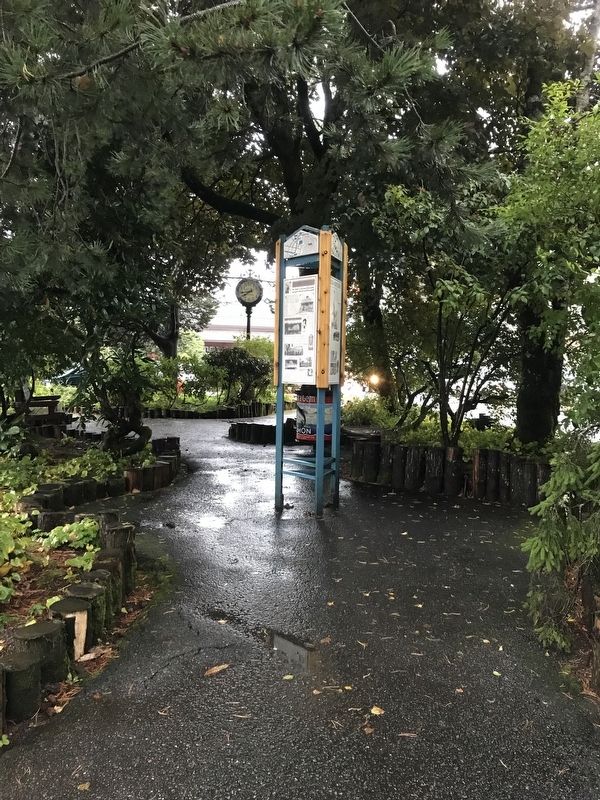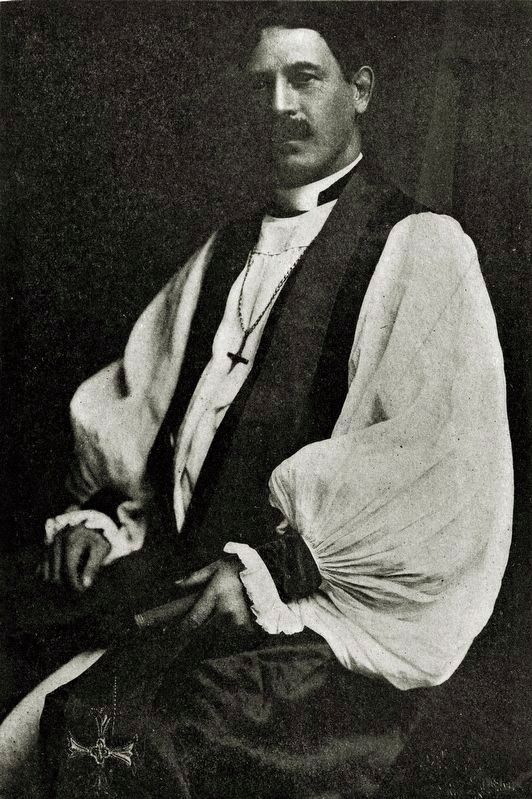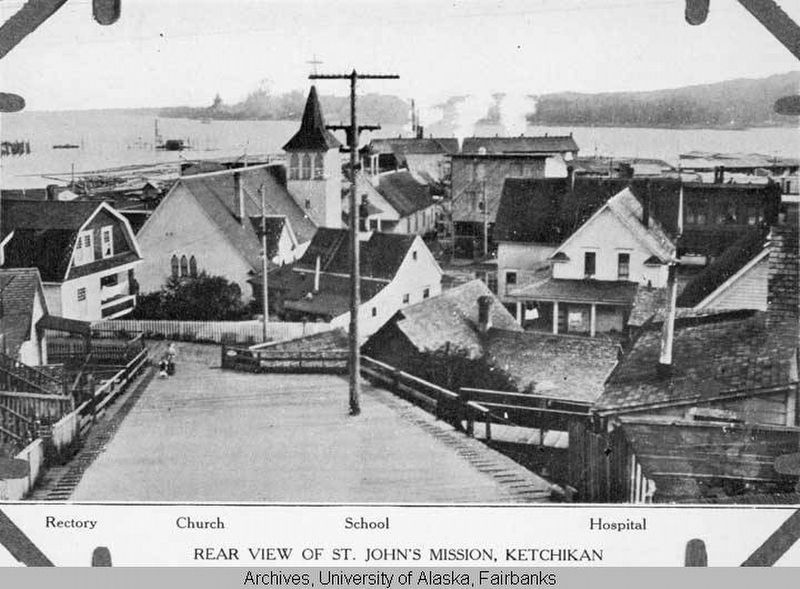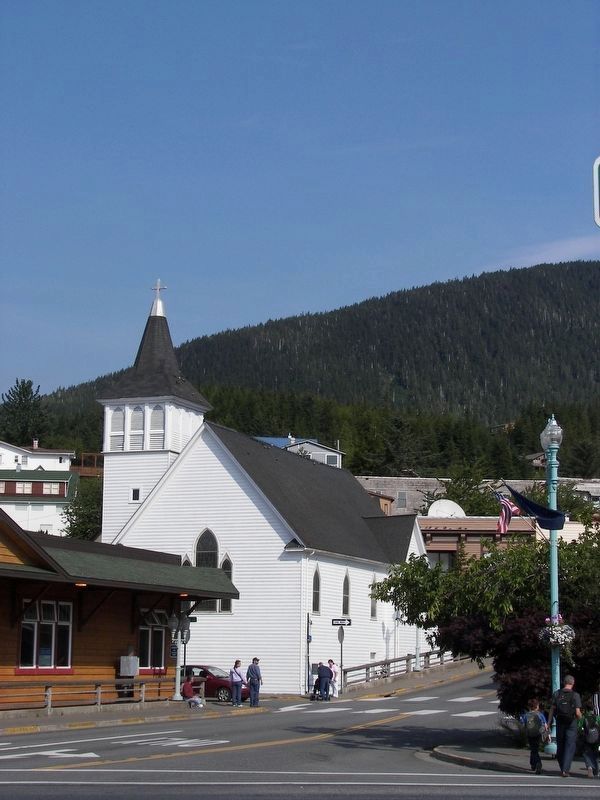Ketchikan in Ketchikan Gateway Borough, Alaska — Northwest (North America)
Crossing a Frontier
St. John's mission brought gospel, school and hospital
“But the above is quite a contrast to what I found [in] Ketchikan in Jan. 1897. It was then an Indian community of a few families. The only white man in the place was a trader. There was no dock. He offered me two acres of his squatters claim if I would start a school for the Indian children. Though a hard man, he had a heart of sympathy for the poor children. I accepted, arranged for a school, and so the work began. — Bishop Peter Trimble Rowe in the 1930s, recounting his mission's founding.If Ketchikan wasn't Godless, it was at least churchless until an Episcopal priest started visiting from the Juneau area in 1897 to offer services. The settlement's only white resident donated two acres of land to Bishop Peter Trimble Rowe to establish a school for Native children. Miss Agnes Edmonds arrived in 1898 to teach in the St. Agnes Mission school — founded in a rough cabin bought from a Native man. The itinerant priest's visits were sporadic in the fast-growing frontier town, and Miss Agnes occasionally conducted informal services for Native people and white newcomers.
A church arises on the rock
Fr. Thomas Jenkins proved to be quite a fisher of men. And money. And man-hours. The Episcopal priest landed in Ketchikan in August 1902 as the first resident pastor for St. Agnes Mission. Days later he drew “100 people of several races” to his first Sunday service in the tiny mission house Miss Agnes had pioneered. Within six weeks Fr. Jenkins raised $850 in the community to start a church building; money from outside supporters filled out the construction fund. Next the priest pulled in Ketchikan's carpenters and contractors — most working as volunteers — to put up a proper church; they started in April 1903 and finished St. John's Church in less than a year. In the early 1930s, the congregation raised the building to insert an undercroft.
The mission of healing
St. John's Hospital opened in 1904 in the mission house, its staff a nurse from Boston. The hospital about 1910 took over the clergy house and the new 12-bed facility was named Arthur Yates Memorial Hospital for the late husband of a financial benefactor in New York. Episcopal Missions supported the hospital. In 1923, the Catholic Sisters of St. Joseph of Peace built a larger hospital on Bawden Street; the Episcopalians closed Yates in 1925.
Fracture and resurgence mark the church
In the early 1920s, St. John's encompassed a church, a mission hospital, a school, a clergy house and a devoted congregation. Then came a crumbling. The hospital was closed as a new Catholic medical facility rose to primacy. Many Native parishioners left in the 1930s to found St. Elizabeth's Church on Deermount Street. But steady resurgence began after World War II. Natives closed their church and returned. In 1987 the congregation put in a new pipe organ and in 1995 they renovated the outside of their sanctuary to restore some of St. John's old glory.
Captions
(Left side, top to bottom)
• Casting a net for Christ in mission country: a new dockside sanctuary for a growing congregation. Tongass Historical Society
• The school Native children and teachers pose ca. 1930 at St. John's. Their church school was across Mission Street for 25 years until the U.S. Office of Indian Affairs took it over. White children had their own school up Main Street in this era of de facto segregation. Children learned the 3 Rs and some trade skills at St. John's School. Tongass Historical Society
• Melodic melting pot: many heritages harmonized in the 1930s junior choir. St. John's Church photo
(Right side, top
to bottom)
• Miss Agnes Edmonds and students at school, ca. 1898. Tongass Historical Society
• Miss Agnes Edmonds Boardwalk Edmonds Street is named for this pioneer of the Episcopal mission.
• Stained glass in the St. John's sanctuary.
• A band serenaded patients in 1922, the mission hospital's late heyday. Tongass Historical Society
• Nurse Lillian Ames on the hospital grounds in 1917. The hospital building would later house undertakers, a magazine, apartments, a printer, a Seamen's Center and a preschool. Tongass Historical Society
Erected by Historic Ketchikan, Inc.
Topics. This historical marker is listed in these topic lists: Churches & Religion • Education • Native Americans • Science & Medicine. A significant historical year for this entry is 1897.
Location. 55° 20.504′ N, 131° 38.612′ W. Marker is in Ketchikan, Alaska, in Ketchikan Gateway Borough. Marker can be reached from Mill Street east of Bawden Street, on the left when traveling east. Marker is in Whale Park. Touch for map. Marker is at or near this postal address: 829 Mill Street, Ketchikan AK 99901, United States of America. Touch for directions.
Other nearby markers. At least 8 other markers are within walking distance of this marker. Sea and Skyline (here, next to this marker); Carving a Place in History (here, next to this marker);
Chief Kyan Totem Pole (a few steps from this marker); Chief Johnson Totem Pole (within shouting distance of this marker); 'Cat' Houses & Sporting Women (within shouting distance of this marker); In Defiance of the Dry Squad (within shouting distance of this marker); Star House (about 300 feet away, measured in a direct line); Ketchikan Shingle Mill (about 400 feet away). Touch for a list and map of all markers in Ketchikan.
Credits. This page was last revised on September 16, 2021. It was originally submitted on September 16, 2021, by Duane and Tracy Marsteller of Murfreesboro, Tennessee. This page has been viewed 214 times since then and 15 times this year. Photos: 1, 2, 3, 4, 5. submitted on September 16, 2021, by Duane and Tracy Marsteller of Murfreesboro, Tennessee.




